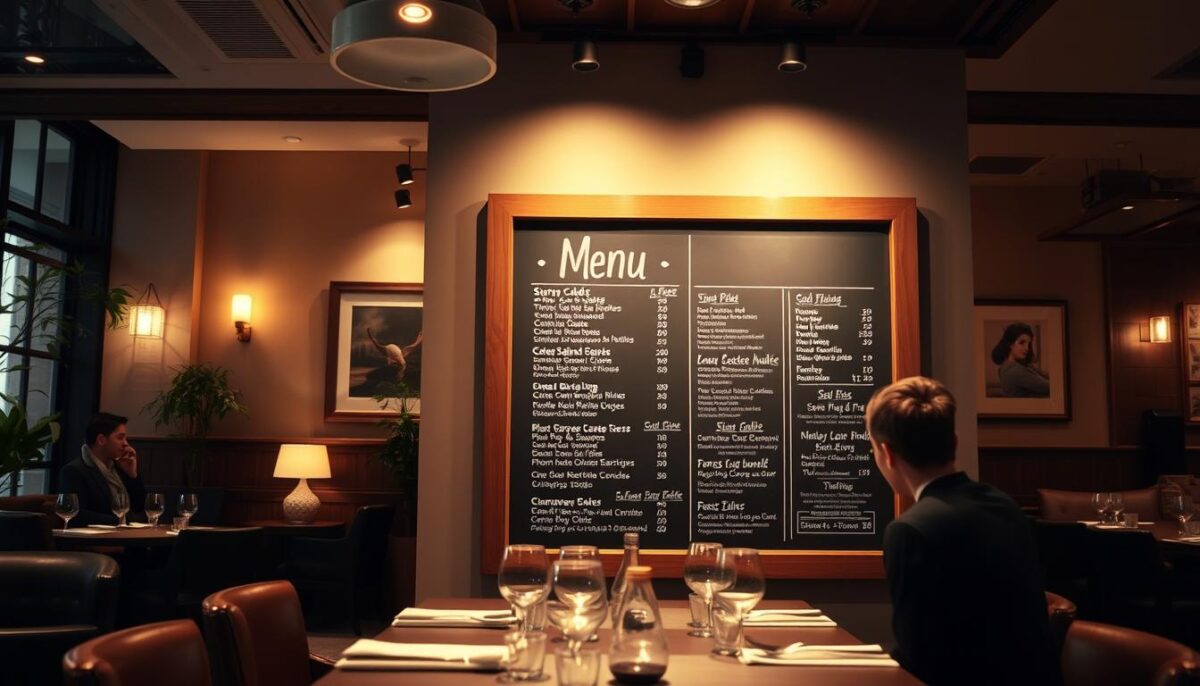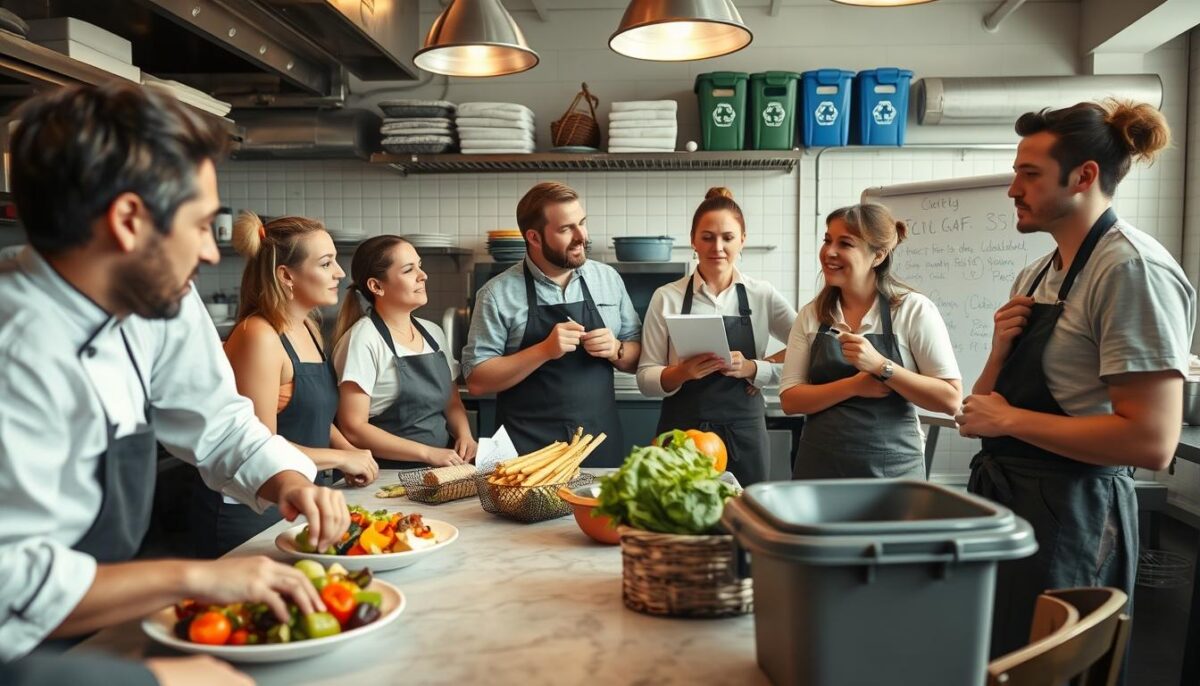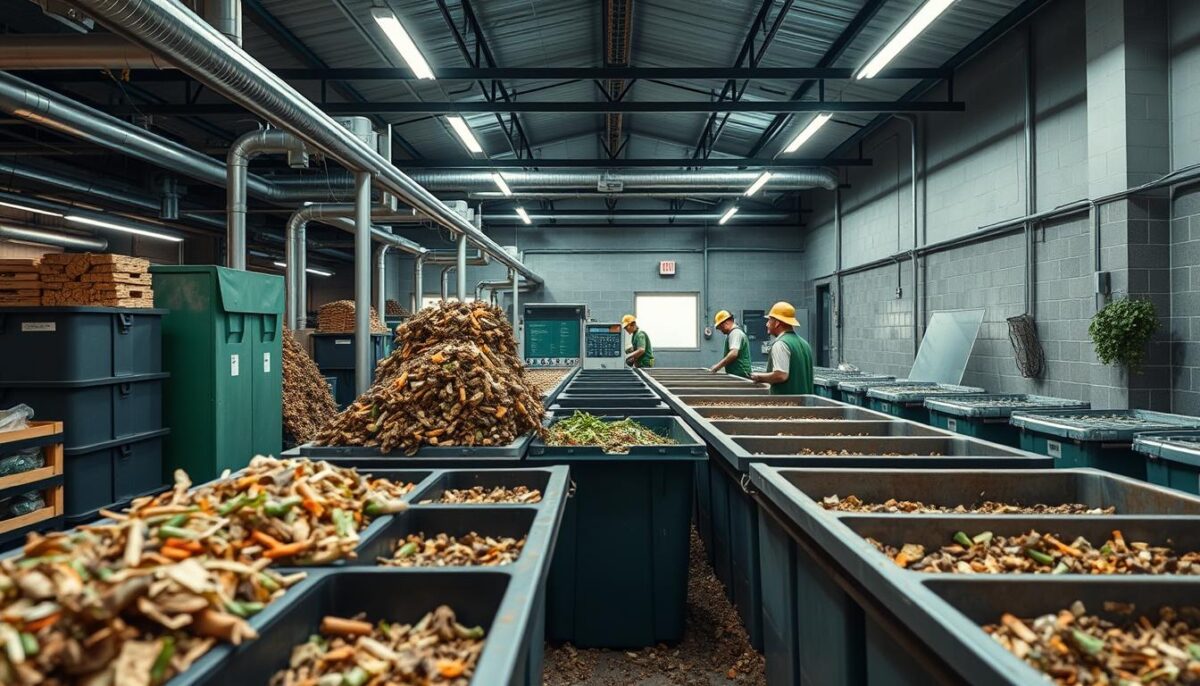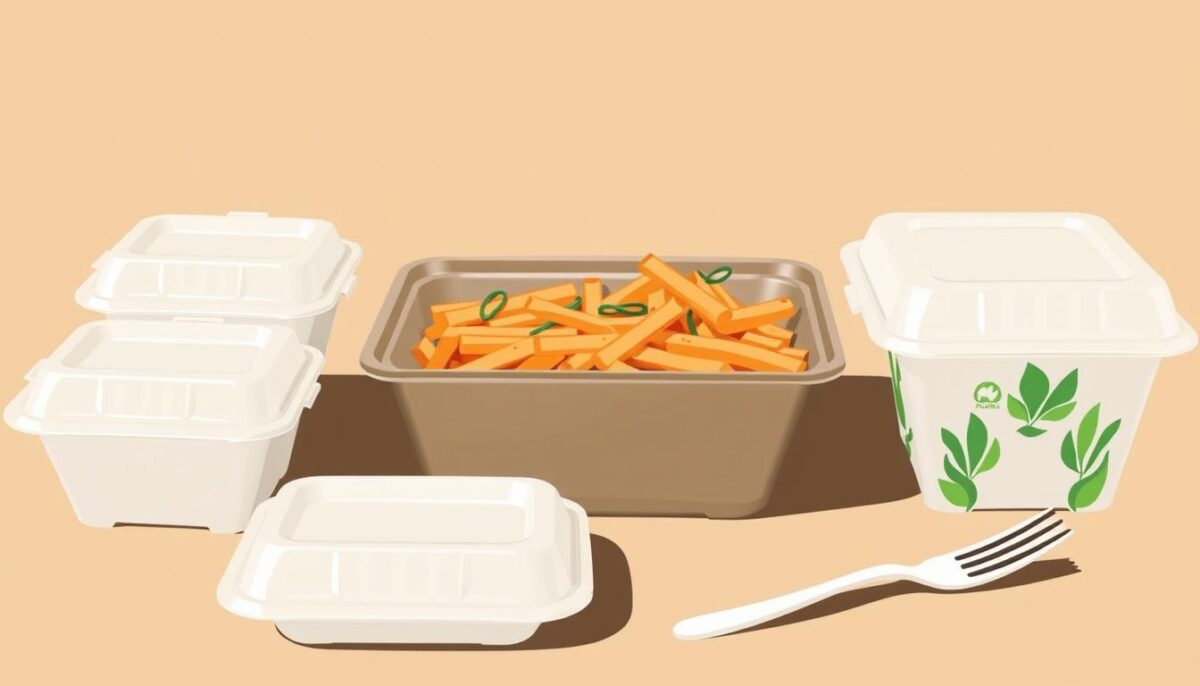
How Chefs Keep Herbs Fresh for Days in Commercial Kitchens
June 24, 2025
Top Steak-Cooking Mistakes Chefs Avoid for Perfect Texture
June 25, 2025I still remember the day I realized the true extent of food waste in my restaurant. It was a staggering moment that made me rethink my business practices and look for ways to minimize waste. Did you know that the U.S. sends more food to landfills than any other single material? This not only harms the environment but also results in significant lost profits for restaurants annually.
As a restaurant owner, I understand the importance of being mindful of our food waste and its impact on our bottom line. By implementing simple yet effective strategies, I was able to significantly cut down on waste while maintaining quality and customer satisfaction. What if you could save thousands of dollars by changing just a few of your restaurant practices?
Key Takeaways
- Simple strategies can significantly reduce food waste in your restaurant.
- Reducing waste can lead to substantial cost savings.
- Customers are increasingly concerned about sustainable practices.
- Implementing waste reduction strategies can improve operational efficiency.
- Reducing food waste is both environmentally responsible and good business sense.
The Hidden Cost of Food Waste in Restaurants
As a restaurant owner, I’m about to reveal a shocking truth: food waste is costing me more than just ingredients. The impact of food waste extends far beyond the kitchen, affecting my bottom line, the environment, and even my customers’ perceptions of my business.
The Environmental Impact
Food waste contributes significantly to environmental problems, including greenhouse gas emissions. When food waste ends up in landfills, it decomposes and produces methane, a potent greenhouse gas. Reducing food waste is not just a business imperative, but also a moral obligation. By minimizing waste, I can help mitigate the environmental impact of my restaurant.
The Financial Impact on My Bottom Line
The financial implications of food waste are substantial. With food costs representing 28% to 35% of sales in restaurants, preventing pre-consumer food waste can significantly boost profitability. For every dollar invested in food-waste reduction, restaurants can realize approximately $8 in cost savings. This is a financial no-brainer for any restaurant looking to improve its bottom line. By reducing waste, I can save money on waste hauling expenses and potentially increase sales by offering specials made from surplus ingredients.
Why My Customers Care About Food Waste
My customers are increasingly environmentally conscious, with research showing that 72% of diners care about how restaurants handle food waste.
“Nearly half of customers are willing to pay more to eat at establishments that actively work to reduce waste.”
By prioritizing food waste reduction, I can not only improve my bottom line but also enhance my restaurant’s reputation and attract environmentally conscious customers.
By understanding the hidden costs of food waste, I can take proactive steps to reduce waste, improve profitability, and contribute to a more sustainable food system.
How to Conduct a Food Waste Audit in My Restaurant
Understanding the sources and extent of food waste is crucial for developing an effective reduction strategy. To achieve this, I need to conduct a thorough food waste audit, which involves tracking and analyzing the waste generated by my restaurant.
Creating a Food Waste Tracking System
To start, I’ll develop a comprehensive food waste tracking system that categorizes different types of waste, such as prep scraps, spoiled ingredients, and plate waste. This system will help me identify problem areas and understand the reasons behind the waste. I’ll use a log template to record waste throughout the day, ensuring that my staff is involved in the process and aware of the importance of accurate tracking.
![]()
Analyzing My Kitchen’s Waste Patterns
Once I’ve collected data over a representative period, typically a week, I’ll analyze the waste patterns to identify trends and areas for improvement. This analysis will reveal insights into my kitchen operations, inventory management, and customer preferences. For instance, I might discover that a particular dish is consistently leaving a lot of waste on the plate, indicating a need to adjust portion sizes or menu offerings.
| Waste Category | Quantity (lbs) | Percentage of Total Waste |
|---|---|---|
| Prep Scraps | 50 | 30% |
| Plate Waste | 30 | 20% |
| Spoiled Ingredients | 20 | 15% |
Setting Measurable Reduction Goals
Based on the findings from my food waste audit, I’ll set specific, measurable reduction goals. These goals will be aligned with my overall business objectives and will guide the implementation of strategies to minimize waste. By regularly reviewing and adjusting these goals, I’ll be able to track progress and make data-driven decisions to optimize my waste reduction efforts.
By following these steps, I’ll be able to conduct a thorough food waste audit and develop a tailored strategy to reduce waste in my restaurant, ultimately improving my bottom line and contributing to a more sustainable food service industry.
Smart Inventory Management to Reduce Food Waste in Restaurants
By implementing smart inventory management practices, restaurants can significantly cut down on food waste. Practicing good inventory management takes more work, but it’s well worth it both for reducing food waste and for keeping better track of a restaurant’s inventory. This helps in understanding demand, identifying underperforming dishes, and increasing profit margins.
Implementing the FIFO Method
The FIFO (First In, First Out) method is a simple yet effective inventory management philosophy that ensures older ingredients are used before newer ones. This approach helps prevent spoilage by using up food items before their best-before or expiration date. By adopting FIFO, restaurants can significantly reduce food waste.
Optimizing My Ordering Process
Optimizing the ordering process is crucial for reducing food waste. By analyzing sales data and seasonal patterns, restaurants can purchase just what they need, avoiding overstocking of perishable items. This not only reduces waste but also helps in maintaining the freshness of ingredients.
Proper Food Storage Techniques
Proper food storage is essential for extending the shelf life of ingredients. Storing food in sealed containers and maintaining the right temperature for perishables like fruits and vegetables can prevent spoilage. Proper storage techniques ensure that ingredients remain fresh for a longer period, reducing the likelihood of waste.
By focusing on smart inventory management practices like FIFO, optimizing ordering processes, and proper storage techniques, restaurants can significantly reduce food waste. This not only benefits the environment but also improves the bottom line by reducing unnecessary costs associated with waste.
Menu Engineering Strategies to Minimize Waste
Effective menu engineering is key to reducing food waste and enhancing the sustainability of my restaurant. By carefully designing my menu, I can minimize the amount of unused ingredients and reduce the environmental impact of my business.
Designing a Cross-Utilization Friendly Menu
One way to reduce wasted food is to be deliberate with my menu design. I strive to offer multiple dishes that reuse some of the same ingredients, thereby reducing the number of items that go unused in my kitchen. For instance, if I use a specific type of lettuce in one salad, I try to incorporate it into other dishes as well. This approach not only reduces waste but also simplifies inventory management.

Rethinking My Portion Sizes
Another strategy I employ is adjusting my portion sizes based on customer feedback and plate waste analysis. By offering the right-sized portions, I can ensure that customers are satisfied while minimizing uneaten food. This approach has not only reduced waste but also improved customer satisfaction.
Creating Specials to Use Excess Ingredients
When I find myself with ingredients nearing their expiration date, I task my chef with creating specials that utilize those ingredients. This not only prevents waste but also offers my customers unique and exciting dishes. For example, I’ve created seasonal specials that incorporate locally sourced ingredients, reducing shipping waste and ensuring fresher ingredients.
| Menu Engineering Strategy | Benefits |
|---|---|
| Cross-utilization of ingredients | Reduces unused ingredients, simplifies inventory |
| Adjusted portion sizes | Minimizes uneaten food, improves customer satisfaction |
| Creating specials | Prevents waste, offers unique dishes |
Building a Food Waste Reduction Culture Among My Staff
I’ve learned that getting my staff involved in food waste reduction efforts is key to achieving our goals. As Dan Simons, co-owner of Founding Farmers Restaurant Group, aptly puts it, “Culture is at the root of any result.” To create a culture of waste awareness, I’ve implemented several strategies that have proven effective.

Training My Team on Waste Prevention
Comprehensive training is essential to educate my team about the environmental and financial impacts of food waste. I’ve developed a training program that covers the importance of waste reduction and the procedures to achieve it. This program includes daily pre-shift meetings where we discuss specific waste reduction goals and celebrate successes.
Creating Staff Incentives for Waste Reduction
To encourage participation, I’ve created a staff incentive program that rewards teams for meeting waste reduction targets. This program has significantly increased staff engagement and motivation to reduce waste. By recognizing and rewarding their efforts, I’ve fostered a sense of ownership among my staff.
Establishing Clear Communication Channels
Clear communication between front-of-house and kitchen staff is crucial to prevent overproduction and miscommunication about customer needs. I’ve established open channels of communication to ensure that everyone is on the same page. This has helped reduce errors and improve overall efficiency.
| Strategy | Impact |
|---|---|
| Comprehensive Training | Educated staff on waste reduction importance |
| Staff Incentives | Increased staff engagement and motivation |
| Clear Communication | Reduced errors and improved efficiency |
Beyond the Kitchen: Creative Solutions for Unavoidable Waste
In my journey to reduce food waste, I’ve discovered that some waste is unavoidable, but there are innovative ways to handle it. As a restaurant owner, it’s essential to think beyond the kitchen and explore creative solutions that not only reduce waste but also benefit the community and the environment.
Donating Surplus Food Safely
I’ve developed partnerships with local food banks and shelters to donate surplus food, turning potential waste into meals for those in need. To do this safely, I’ve become familiar with the Bill Emerson Good Samaritan Food Donation Act, which provides liability protection. Understanding food safety regulations is crucial when donating food to ensure it reaches those in need without causing harm.
Implementing a Composting Program
For unavoidable food scraps, I’ve implemented a composting program, which has significantly reduced my waste hauling costs. By working with local composting facilities, I’ve established a pickup schedule and proper sorting procedures that work for my restaurant’s volume. This not only reduces waste but also contributes to a comprehensive waste diversion strategy.

Eco-Friendly To-Go Options for Leftovers
To reduce packaging waste and encourage customers to take home leftovers, I’ve switched to eco-friendly to-go containers. Using compostable takeout containers and biodegradable cutlery is a simple yet effective way to reduce my restaurant’s environmental impact. I also promote the use of these eco-friendly options through positive messaging about reducing waste.

By implementing these creative solutions, my restaurant not only reduces food waste but also enhances its community impact and appeals to environmentally conscious customers. Tracking and promoting waste diversion efforts are key components of my marketing strategy, showcasing my commitment to sustainability.
Conclusion: Making Food Waste Reduction a Profitable Long-Term Strategy
By implementing effective food waste reduction strategies, my restaurant has not only reduced its environmental impact but also improved its financial performance. I’ve discovered that reducing food waste isn’t just an environmental initiative—it’s become a core business strategy that has significantly improved my restaurant’s profitability.
The six key strategies I’ve implemented have had the biggest impact on reducing waste and increasing my bottom line. I’ve tracked my progress over time and found that my initial investment in waste reduction tools and training has paid for itself many times over through cost savings.
To continue measuring and refining my waste reduction efforts, I conduct regular audits to identify new opportunities for improvement. For every dollar invested in food waste reduction, my restaurant has realized approximately $8 in cost savings, making this one of my most profitable business decisions.
By integrating waste reduction into my restaurant’s brand identity, I’ve attracted environmentally conscious customers and increased sales. I encourage other restaurant owners to begin their own food waste reduction journey with simple, low-cost first steps that can lead to significant long-term benefits.
FAQ
How can I identify the sources of food waste in my restaurant?
To identify the sources of food waste, I conduct a thorough audit of my kitchen’s operations, tracking the types and amounts of waste generated during food preparation, cooking, and serving. This helps me pinpoint areas where I can improve my inventory management and menu planning.
What are some effective strategies for minimizing food waste through inventory management?
I implement the FIFO method to ensure that older ingredients are used before they expire. I also optimize my ordering process by analyzing sales data and adjusting my inventory levels accordingly. Proper food storage techniques, such as labeling and dating stored items, also help me reduce waste.
How can I adjust my menu to minimize food waste?
I design my menu to incorporate cross-utilization, using the same ingredients in multiple dishes. I also consider rethinking my portion sizes to reduce the amount of excess food. Creating specials or promotions to use up excess ingredients is another strategy I use to minimize waste.
What role does staff training play in reducing food waste?
Training my staff on waste prevention strategies and techniques is crucial to reducing food waste. I educate them on the importance of proper inventory management, food storage, and preparation methods. By empowering my staff with the knowledge and skills to reduce waste, I can create a culture of sustainability in my restaurant.
How can I measure the success of my food waste reduction efforts?
I track key performance indicators (KPIs) such as the amount of waste generated, the cost savings achieved, and the impact on my bottom line. By regularly monitoring these metrics, I can assess the effectiveness of my food waste reduction strategies and make adjustments as needed.
What are some creative solutions for managing unavoidable food waste?
I consider donating surplus food to local food banks or shelters, implementing a composting program to turn food scraps into nutrient-rich soil, or offering eco-friendly to-go options for leftovers. These strategies help me minimize the environmental impact of my restaurant’s operations while also reducing waste.



